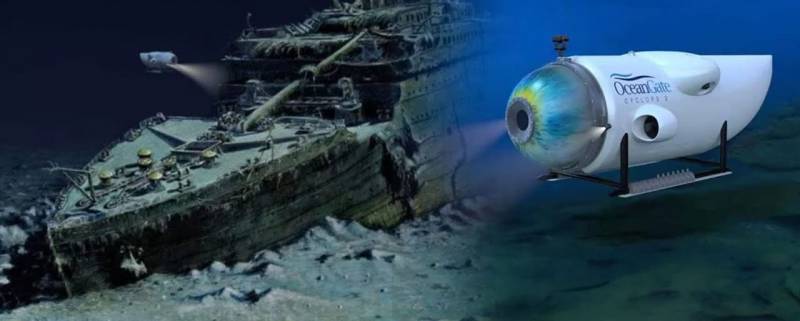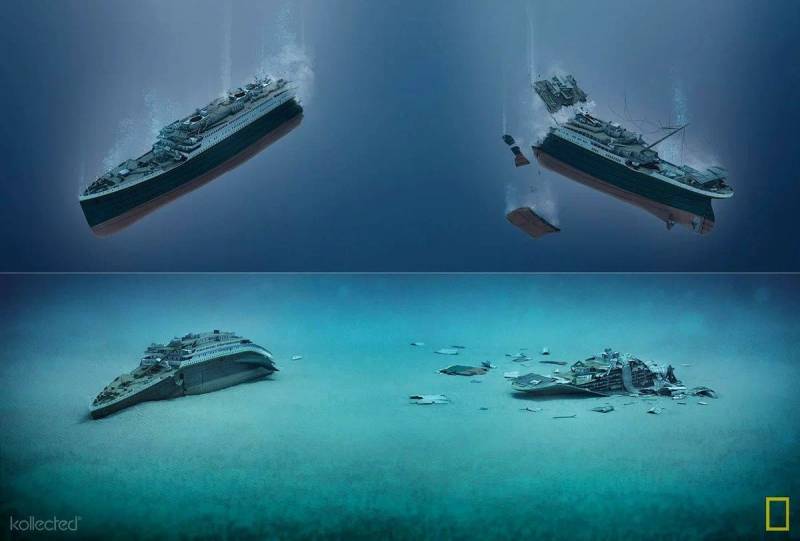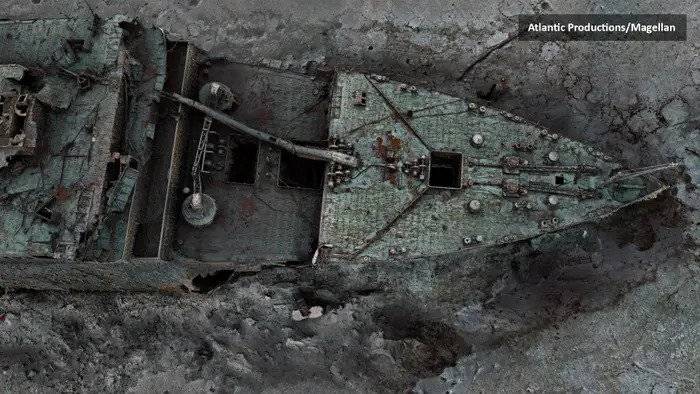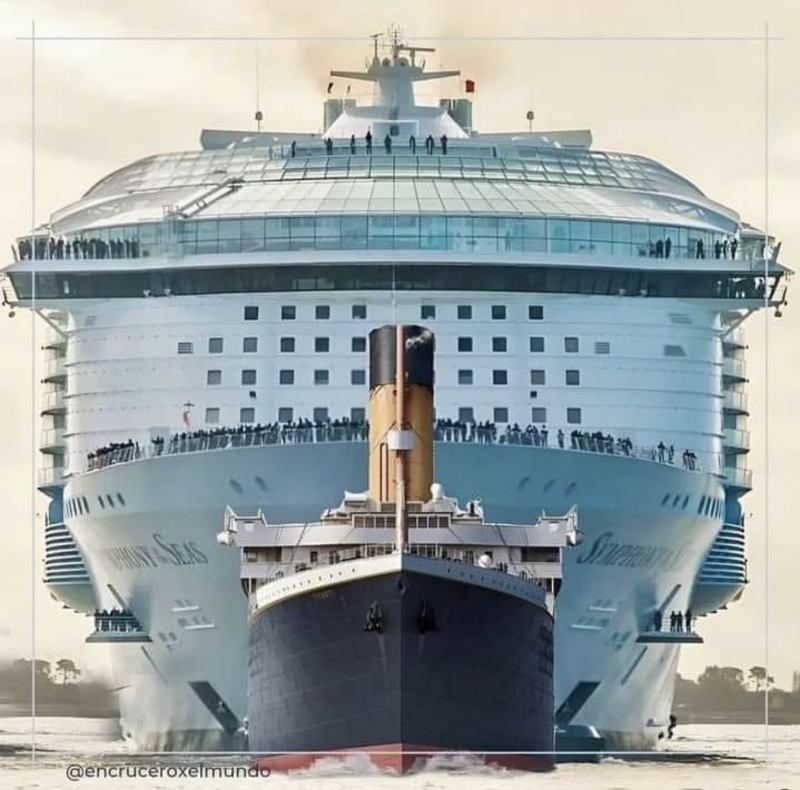How fast did the Titanic sink?

Around 2:20 am, the waves closed over the stern of the Titanic. And the next one started story.
Somewhere above, the surface of the night ocean swayed, and the wreckage of the liner was carried away to the bottom. What was this path like - through 4 kilometers of dark, scalding icy water?
What happened to the Titanic in the first minutes after it disappeared from the surface?
Under normal conditions, the margin of longitudinal stability of surface ships is unshakably large. A tip submerged above the norm immediately causes an increase in the buoyancy force, and the shoulder of the restoring moment in this case can reach half the length of the hull. It happens that ships capsize on board - but no one has yet capsized through the bow or stern (without extensive flooding of the compartments).
For fully submerged floating bodies, there are no changes in the displacing volume at any inclination. Because of this, for example, difficulties arise in the management of submarines - where, along with the roll, it is necessary to monitor the trim. Maintaining balance in a horizontal position is possible only with the coordinated work of the rudders and ballast tanks.
There is no one to monitor the balance of sinking ships. Due to the uneven distribution of masses inside the hull, all of them, being completely in the water, inevitably tend to take a vertical position - and with a trim of 90 degrees they dissolve in the blue abyss.
As if in slow motion, settling in the water column, the liner touched the ocean floor
What happened during this "immersion"? Below is a chilling comparison.
Two steam engines and a Titanic turbine developed a combined power of 55 horsepower. with., which provided the liner with a maximum speed of 23 knots.
When dividing the power by the speed, it turns out that the propellers of the liner created a thrust of about 600 tons. This value was enough to keep the Titanic in full swing.
The mass of the Titanic exceeded the value of 50 tons. If the liner sank in one piece under the influence of only one force of gravity, then it would be pulled to the bottom with a force 80 times greater than the thrust of three propellers at full speed!
When moving in an aquatic environment, thrust and speed are related by an inverse cubic relationship. In other words, an 80 times greater applied force would make it possible to gain "only" 4,3 times greater speed. In the extreme case, when diving into the Mariana Trench, the Titanic could accelerate to 100 knots!
The real depth at the site of the sinking of the Titanic did not reach 4 kilometers. The influence of the buoyant force was not taken into account. Steel is 7,8 times denser than water, but the force of Archimedes will inevitably make its own adjustments. The formation of "air pockets" inside the flooded hull was not taken into account. As well as the resistance to movement from what was once the freeboard and superstructure of the liner. All these elements would create noticeably more resistance than a smooth bottom with hydrodynamically correct contours.

Visualization of the depth at which the wreckage of the Titanic is located. A 100-story skyscraper was chosen as a measure
The hull of the real Titanic was split into pieces. In this form, despite the forms far from perfect, with pieces of metal sticking out in all directions, the bow of the liner crashed into the bottom at a speed of 20 knots, burrowing into the silt at the base of the anchors. These are the officially announced results obtained during the study of the wreckage of the Titanic.
When flooded at a depth of several kilometers, ships sink at a very high speed, which can exceed their full speed. The whirlpools that occur when the hull suddenly stops when it touches the bottom add to the destruction.
Therefore, all ships sunk at great depths are so badly broken and deformed.
For example, the hull of the Japanese aircraft carrier Akagi collapsed and went like an accordion after falling to a depth of 5400 m.

The powerful hull of the Bismarck (flooding depth - 4790 m) withstood the fall, but the entire “soft” aft end of the Nazi battleship disappeared. Crumpled and torn off at the meeting with the bottom.
The destroyer "Johnston", lying at the bottom of the Philippine Sea (6468 m - at the deepest depth among all the sunken ships discovered), was completely destroyed when it hit the bottom. Ceased to exist in the form of an integral structure.
For all who are interested in the case of "Johnston", I will leave such a remark. The first images given out in Internet search engines do not correspond to reality. A slightly more thorough search provides comprehensive information about the state of the wreckage of the heroic ship. But this is an extreme case - flooding in the extremely deep Philippine Sea.
Finally, the Titanic. The bow of its hull, about 140 meters long, was bent in half by a blow. The skin burst and opened, the body of the front superstructure bent down by 10 °.
The stern part of the liner is hardly recognizable - it was badly destroyed during the dive and turned into a vast field of debris.

And did you notice something remarkable?
Ships sunk at shallow depths can be in different positions. But everyone who sank at a depth of several kilometers usually stands on an even keel.
This choice occurs even when "falling" into the abyss of the sea. Initially, everyone goes to the bottom vertically. But where the depth is too great, the hull manages to pick up high speed. The growing resistance from the superstructures and the upper part of the hull creates a moment of forces that tends to "turn" the ship into a position tending to a position on an even keel.
According to modern calculations, the bow of the Titanic met the bottom at an angle of about 45 degrees.
Leaving aside various ethical issues, such research may well qualify for the Ig Nobel Prize. But you must admit, it was damn curious - to the point of chilling goosebumps, to think about what happens to the ship immediately after it disappears under the surface of the ocean.
"Titanic" and "Titan"
After the death of the deep-sea manned submersible "Titan", all visitors to the VO at once turned into bathyscaphe designers. They shared their expert opinion and found more and more flaws in the design of the Titan.
In order to bring some order into the reasoning, it is worth noting that the strength of the hull has long been not a limiter when conquering the depths of the sea.
The history of the Trieste bathyscaphe, which reached the bottom of the deepest depression in 1960, once again proves this thesis. Two glued steel hemispheres with a shell thickness of 127 mm. The estimated depth that the Trieste design could withstand was 16 kilometers - if there were such depths anywhere in the ocean.
Unlike the archaic Trieste, most modern submarines have difficulty submerging even half a kilometer. This has nothing to do with the fears of the designers for the strength of their hulls. Unlike bathyscaphes, submarines have the ability to repeatedly dive and resurface. On their own, without the help of auxiliary vessels. This is possible only with the use of ballast tanks. And if the filling of outboard water does not raise questions, then everything rests on purging the tanks with compressed air - to float to the surface.
The depth of submersion of all submarines is limited by the technical aspects of the use of high pressure air and its reserves on board. As for the strength of their hulls, the choice of designs and materials is determined by the requirements of the depth from which submarines are able to surface. Typically several hundred meters. It makes no sense to make a heavy-duty hull for diving for kilometers - a warship is still not able to rise from such a depth.
Air reserves can be stored on board at a pressure of over 300 atmospheres, and theoretically this could be enough to ascend from depths of up to 3000 meters. But in practice, supplying air under such pressure to the tanks will immediately cause freezing and blockage of all fittings. At the same time creating the risk of compression explosions of oil vapors in the system. Finally, the design of pipelines and valves - the widespread use of air under such pressure will create unacceptable risks and difficulties on board the submarine.
Frosting of the valves was a decisive factor in the sinking of the American submarine Thresher (1963). A chain of technical problems led to the need for emergency purging of tanks at great depths, with disastrous results.
To purge the trim and leveling tanks, "working" air of medium and low pressure (100-200 atm.) is used. But this is only the beginning of the difficulties. Every 10 meters of depth increases the outboard pressure by 1 atmosphere - at a depth of 500 meters, 5 times more air is required to displace water from tanks of the same volume than at a depth of 50 meters.
A further assault on the depth in this way appears to be an unpromising exercise. To conquer kilometer depths, devices with other principles of immersion-ascent are required.
Unlike submarines, deep-sea submersibles are a float with a fixed ballast. The simplest and most effective solutions. But only with complete dependence on the support vessel. Without loading a new portion of ballast, the next dive will not happen.
In its classic form, the float was a tank with ordinary gasoline. Or 8 cubic meters of polymer foam - this technique was used on deep-sea submersibles of the Mir series.
The placement of the ballast also did not require super-technologies. Half a century ago, in the era of Trieste, lead shot was used, held in a funnel by an electromagnet. Nowadays, other similar options are possible. For example, the “galvanic” ballast clamps in the Deepsea Challenger bathyscaphe, corroding in sea water over a calculated period of time. The inevitable separation of the ballast - followed by the ascent of the bathyscaphe to the surface.
For 70 years of deep-sea research, ensuring the strength of the bathyscaphe gondola has become an ordinary task. Already the first representative of this class of technology - designed in the late 1940s. bathyscaphe FNRS-2 had an estimated immersion depth of 4000 m!
In June of this year, an unthinkable event happened - the shipwreck of the Titan.
For the first time in history, a bathyscaphe was crushed at depth by water pressure.
There will be no harsh expert opinions here, but it seems that the creators of the "Titan" approached the issues of ensuring the strength of the hull too presumptuous, focusing on other problems.
And there were many.
Diving to the wreck of the Titanic is very different in complexity from the "ordinary" exploration of the ocean floor. Control of a bathyscaphe in total darkness, in jets of unknown bottom currents. Near a huge metal structure as high as a 16-story building.
Follow the spot of the searchlight through the foggy small porthole, relying only on low-powered water jets, with which the device was barely able to develop a speed of 3 knots.

The presence on board at the time of the crash of the founder and owner of the company that owned the Titan rejects all versions of malicious intent. Stockton Rush really believed in his offspring. "Titan" was saturated with modern systems for monitoring the condition of the hull. Acoustic and strain gauges were supposed to give advance warning of a growing problem, which would force the crew to abandon further diving into the depth.
Many parts of the bathyscaphe were not certified. However, such private craft are exotic designs for operation in international waters where no safety regulations apply. The creators of these submersibles, billionaire fanatics, believe in their own genius and sincerely believe that industry standards "unnecessarily prioritize safety over innovation." In continuation - the words of S. Rush himself:
Another example - the ultra-deep-sea Deepsea Challenger was a real home-made, in which James Cameron, at his own peril and risk, went to conquer the Mariana Trench (successfully).
The version with a dive below the calculated depth also disappears - the Titan itself successfully dived to the Titanic at least twice, in 2021 and 2022. In total, OceanGate deep-sea vehicles managed to deliver about 80 people to this place!
The cylindrical shape of the robust hull is not optimal for withstanding the pressure of the deep sea. But the form is determined by the tasks. For example, submarines traditionally have a strong cylindrical hull, but this does not raise any questions.
OceanGate pursued the task of building a capacious bathyscaphe, designed for five people at once. The very depth at which the Titanic lies (3750 meters) has not been considered something transcendent for a long time. For example, the Soviet "Mir-1" and "Mir-2" had an operating depth of 6000 meters. Where completely different requirements are imposed on the strength of the body of the apparatus.
Everything that diving experts (including the famous J. Cameron) pay attention to mainly relates to the material from which the Titan's hull was built. 800 layers of carbon fiber with a total thickness of 127 mm (5 inches).
Cylindrical tanks and pipes made of carbon fiber have long been successfully used in high-pressure systems, where tensile loads act on the walls from the inside. In the construction of a bathyscaphe, all the advantages of composite materials are useless - carbon fiber structures do not work well in compression.
In conclusion, it is worth quoting the words of Cameron, in which the fatal similarity of the two catastrophes is striking:
Like the captain of a legendary liner, the owner of OceanGate drove his Titan to deadly depths, regardless of the opinions of other venerable experts from the "rich and desperate" club. Which for several years directly told him about the unsuitability of such an apparatus for storming great depths ...

Comparison of the dimensions of the Titanic with a modern liner. Still, 100 years matter
Information